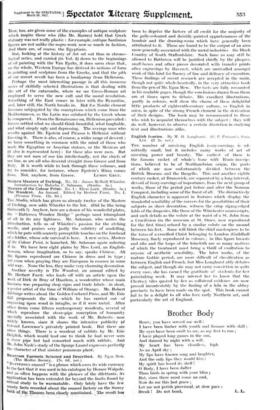English Ivories. By M. H. Longhurst. (G. I'. Putnam's Sons,
Ltd. £2 2s. net.)
Tin,. number of surviving English .ivory-earvings is ad- mittedly small, but it includes many works of art of arresting power and beauty. The earliest of these is the famous casket of whale's bone with Runic inscrip- tions, believed to be of Northwnbrian origin, the parts of which are now unfortunately divided between the British Museum and the Bargello. This and another eighth century casket, at Brunswick, are separated by a long interval, devoid of ivory-carvings of importance, from the next group of works, those of the period just before and after the Norman Conquest, including some of the finest of all. The distinctively English character is apparent in features which display the wonderful sensibility of the carvers for the possibilities of their subjects as sheer decoration, witness the crisp zigzag-edged folds of the draperies, like those of the Winchester manuscripts, and such details as the volute at the waist of a St. John from a Crucifixion (in the museum at St. Omer, now reproduced for the first time) echoed by a similar volute on the mound between his feet. Some will think the chief masterpiece to be the torso of a crucified Christ belonging to London (Guildhall Museum), finely reproduced in colours ; in this figure breasts and ribs and the loops of the loincloth arc so many motives of which the treatment must bring a thrill of exultation to anyone of aesthetic sensibility. The later works, of the mature Gothic period, are more difficult of classification as between English and French, but Miss Longhurst ably debates the subject, and though she may not carry conviction in quite every case, she has earned the gratitude of students for her painstaking work. It may interest her to know that the ChertseY tiles quoted by her as collateral evidence are now proved incontestably by the finding of a kiln in the abbey precincts to have been made on the spot. This book cannot fail to be a delight to all who love early Northern art, and particularly the art of England.






















































 Previous page
Previous page